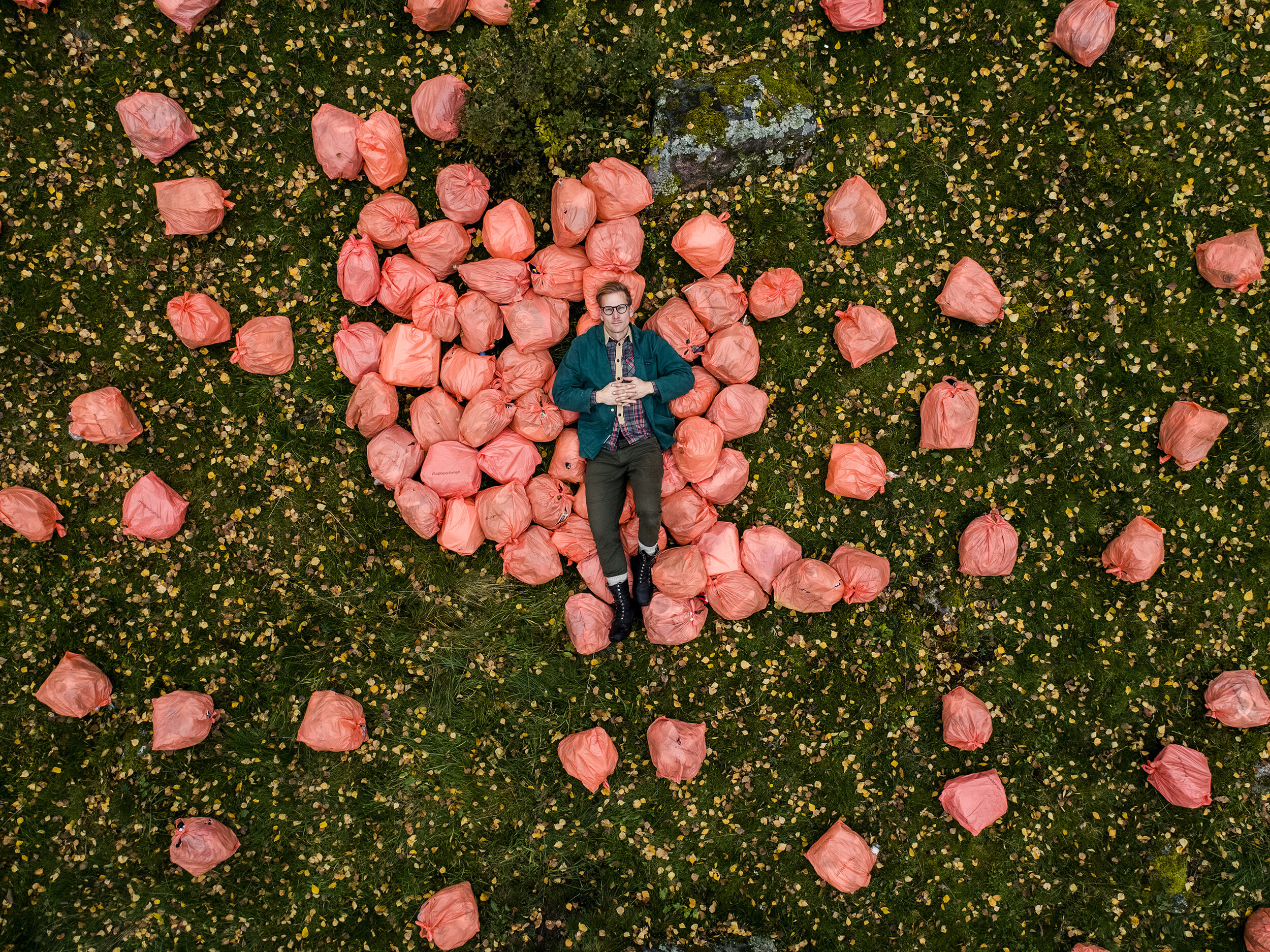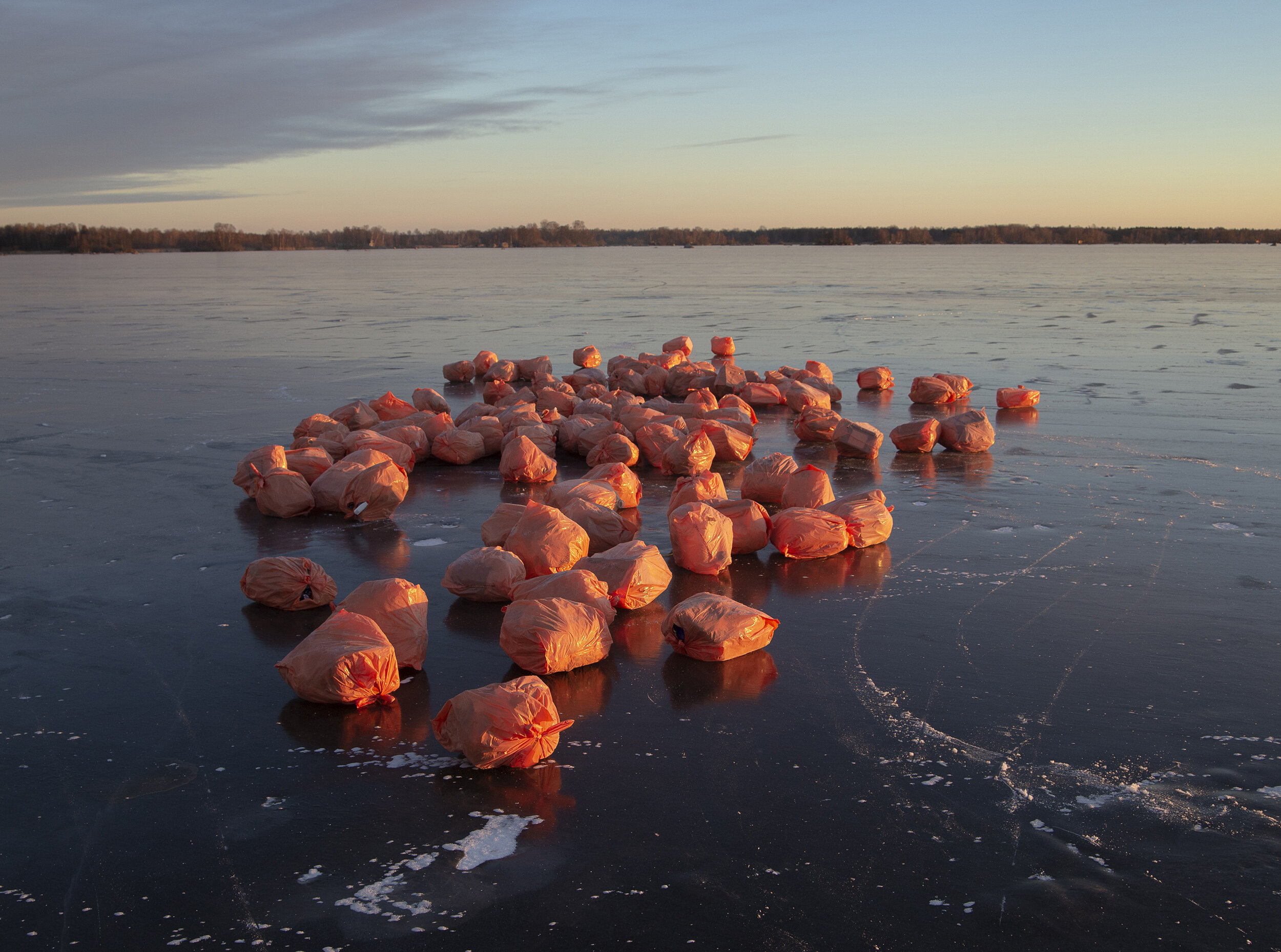Wrapped Up | Mattias Käll

An Artist’s Response to the Packaging Pandemic
Mattias Käll is fascinated by how we humans relate to each other, but also toward our environment. Through a variety of media, Mattias explores issues of climate change, with particular focus on aspects such as consumer habits and over-consumption. In this post, the artist – who lives with his wife and three children in Örebro, Sweden – describes his 2018 project Förpackad (Wrapped up). Over the course of a year, the artist collected each piece of his family’s plastic packaging – documenting the process as he went.
Mattias tells us of his deep concern over our consumption habits and skewed attitude toward resources. “This unease triggered me to embark upon the project… I wanted to see the total amount of plastic waste passing through our household, to feel the physical weight of it.”
Lake Hjälmaren lies at the edge of the artist’s home. In January 2018, he arranged the first batch of his filled recycling bags out on the ice.
January
According to data gathered by National Geographic, plastic production has increased exponentially, from 2.3 million tons in 1950 to 448 million tons by 2015. Production is expected to double by 2050. Nearly one-third of plastic produced in recent years has gone into single-use packaging. Shockingly, only around ten percent has ever been recycled; the majority going to landfill, incineration plants (adding to emissions and increasing air pollution) or left uncollected, often sloughing into our waters.
“In Sweden where I live, we’re pretty good at collecting and reusing plastics. We collect 40% of all packaging plastics for reuse or energy. At the beginning of the project, I was told that 40% of the collected material was re-circulated. During the project, I discovered that the true amount was more like 20%. A large amount is burned for energy, resulting in hefty CO2-emissions.”
“There’s five of us in my household and so this results in a lot of plastic packaging. I collected it all in red plastic bags, storing them in my garage.” Every month another ten bags were added to Mattias’ collection.
March
April
At monthly intervals, Mattias transported and arranged the bags in the countryside close to his home in central Sweden. In so doing, Mattias contrasted the artificial red against the lush landscape in a striking theatrical act. The natural ecosystem set alongside the material that interferes and disrupts the system. Bags scattered across remote hillsides, or slipping into the water. For, nowhere on Earth is free from plastic pollution.
“I chose places where my family and I have spent time. Places I like. Places my kids have played, where we’ve had a picnic or rested in fields of spring flowers... The most beautiful; and the plastics: I find that clash really interesting.”
July
August
“My aim was to make something visible that’s overlooked; or, perhaps it’s better to say that the issue is less overlooked than simply hidden in plain sight … the plastics make their way into nature one way or another: either as litter or as carbon dioxide.”
In some cases, the artist carried the bags for several kilometres. Thus, the weight of the walk became an important element of the project. “It makes an abstract problem physical and complicated and really sweaty. I had been offered a chance to feel and experience the weight we put on nature.”
November
December
Viewed as a series of photographs – each one beautifully composed – the power of Mattias’ commitment is striking. The now familiar red bags grow in volume often filling the frame. Familiar is the operative word here, for the very fact that bags like these form part of our day-to-day lives highlights the ease by which we might overlook them, and what they represent. The same frozen Lake Hjälmaren that supported eight filled bags in January now bears the weight of 118 in December. By returning the bags to the location of the first shoot, Mattias’ cyclic action enforces the need for a truly sustainable economy. Most powerfully, though, is the artist’s decision to photograph the bags on ice. The weight of 118 bags on the season’s first ice brings a tension that illustrates the very essence of his project. If the ice here represents planetary collapse, then the first cracks will most certainly be visible.
Since producing the year-long project, the artist has gone on to exhibit it in a range of venues in his native Sweden, often combining photographs with the red bags supported on sculptural plints. Find out more on his website.
Artwork images above © the artist | Used with permission | Cover portrait by Terese Andersson and aerial headline photograph by Roine Magnusson; used with permission from the artist















